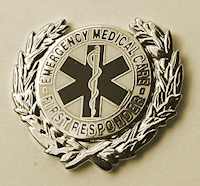|

Preparation
 A high school
diploma is usually required to enter a formal emergency medical technician
training program. Training is offered at progressive levels: EMT-Basic,
EMT-Intermediate, and EMT-Paramedic. A high school
diploma is usually required to enter a formal emergency medical technician
training program. Training is offered at progressive levels: EMT-Basic,
EMT-Intermediate, and EMT-Paramedic.
At the EMT-Basic level, coursework emphasizes emergency
skills, such as managing respiratory, trauma, and cardiac emergencies, and
patient assessment. Formal courses are often combined with time in an
emergency room or ambulance. The program provides instruction and practice
in dealing with bleeding, fractures, airway obstruction, cardiac arrest,
and emergency childbirth. Students learn how to use and maintain common
emergency equipment, such as backboards, suction devices, splints, oxygen
delivery systems, and stretchers. Graduates of approved EMT-Basic training
programs must pass a written and practical examination administered by the
State certifying agency or the National
Registry of Emergency Medical Technicians (NREMT).
At the EMT-Intermediate level, training requirements vary by
state. The nationally defined levels (EMT-Intermediate 1985 and
EMT-Intermediate 1999) typically require 30 to 350 hours of training based
on scope of practice. Students learn advanced skills such the use of
advanced airway devices, intravenous fluids, and some medications.
All 50 States require certification for each of the EMT
levels. In most States and the District of Columbia registration with the
NREMT is required at some or all levels of certification. Other States
administer their own certification examination or provide the option of
taking either the NREMT or State examination. To maintain certification,
EMTs and paramedics must recertify, usually every 2 years. Generally, they
must be working as an EMT or paramedic and meet a continuing education
requirement.
The most advanced level of training for this occupation is
EMT-Paramedic. At this level, the caregiver receives training in anatomy
and physiology as well as advanced medical skills. Most commonly, the
training is conducted in community colleges and technical schools over 1 to
2 years and may result in an associate's degree. Those considering this
area of work should ensure that the program they choose to study is
accredited by the Committee
on Accreditation for EMS Professionals. Such education prepares the
graduate to take the NREMT examination and become certified as a Paramedic.
Extensive related coursework and clinical and field experience is required.
Refresher courses and continuing education are available for EMTs and
paramedics at all levels.
Note: Some resources in this section are provided by the US
Department of Labor, Bureau of Labor
Statistics.
|
|